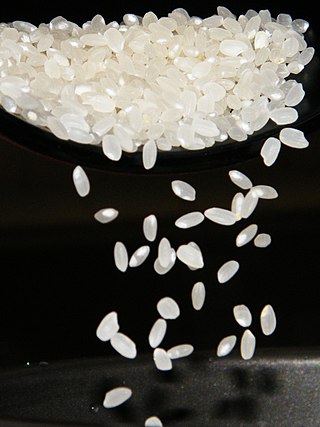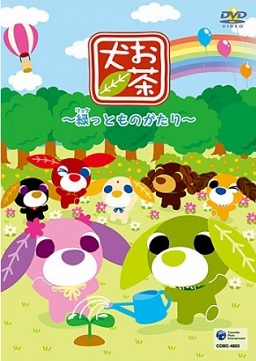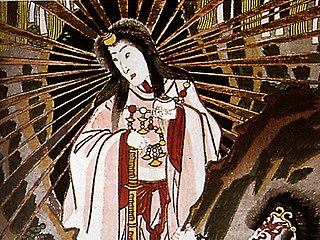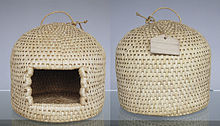
Straw is an agricultural byproduct consisting of the dry stalks of cereal plants after the grain and chaff have been removed. It makes up about half of the yield of cereal crops such as barley, oats, rice, rye and wheat. It has a number of different uses, including fuel, livestock bedding and fodder, thatching and basket making.

Niigata Prefecture is a prefecture in the Chūbu region of Honshu of Japan. Niigata Prefecture has a population of 2,227,496 and is the fifth-largest prefecture of Japan by geographic area at 12,584.18 km2 (4,858.78 sq mi). Niigata Prefecture borders Toyama Prefecture and Nagano Prefecture to the southwest, Gunma Prefecture to the south, Fukushima Prefecture to the east, and Yamagata Prefecture to the northeast.

The E4 series (E4系) was a high-speed shinkansen train type operated by East Japan Railway Company in Japan. They were the second series of completely bi-level Shinkansen trainsets to be built in Japan. They previously operated on the Tōhoku and Jōetsu Shinkansen, and occasionally on the Nagano Shinkansen. E4 series trains feature double-decker cars to accommodate additional commuter traffic around Tokyo and other urban areas. They were often coupled to 400 series trains on the Tōhoku Shinkansen between Tokyo and Fukushima before the latter retired in April 2010. The last trains of the E4 series were withdrawn from regular service on 1 October 2021.

Zori, also rendered as zōri, are thonged Japanese sandals made of rice straw, cloth, lacquered wood, leather, rubber, or—most commonly and informally—synthetic materials. They are a slip-on descendant of the tied-on waraji sandal.

Waraji are light tie-on sandals, made from ropemaking fibers, that were the standard footwear of the common people in Japan.

The maneki-neko is a common Japanese figurine which is often believed to bring good luck to the owner. In modern times, they are usually made of ceramic or plastic. The figurine depicts a cat, traditionally a calico Japanese Bobtail, with a paw raised in a Japanese beckoning gesture. The figurines are often displayed in shops, restaurants, pachinko parlors, dry cleaners, laundromats, bars, casinos, hotels, nightclubs, and other businesses, generally near the entrance. Some maneki-neko are equipped with a mechanical paw which slowly moves back and forth.

Yuzawa is a town located in Niigata Prefecture, Japan. As of 1 July 2019, the town had an estimated population of 7,926, and a population density of 22.2 persons per km2. The total area of the town was 357.29 square kilometres (137.95 sq mi). The town is famous for its hot springs.

Yamakoshi was a village located in Koshi District, Niigata Prefecture, Japan.

A bassinet, bassinette, or cradle is a bed specifically for babies from birth to about four months. Bassinets are generally designed to work with fixed legs or caster wheels, while cradles are generally designed to provide a rocking or gliding motion. Bassinets and cradles are distinguished from Moses baskets and carry cots, which are designed to be carried and sit directly on the floor or furniture. After four months, babies are often transferred to a crib or cot. In the United States, however, the bedside sleeper is the prevalent option, since they are generally bigger, recommended up to 6 months, and often used up to a year.

Tainai is a city located in Niigata Prefecture, Japan. As of 31 December 2020, the city had an estimated population of 28,495 in 10,821 households, and a population density of 110 persons per km2. The total area of the city was 264.89 square kilometres (102.27 sq mi).

Koshihikari is a popular cultivar of Japonica rice cultivated in Japan as well as Australia and the United States.

Ocha-Ken (お茶犬) means in Japanese "tea puppy" or "tea dog". They are colorful puppies, most of them with leaves for ears, representing "tea leaves". They were first introduced as toys released by Sega Toys. Later, due to the popularity, an animated series was made based on the Ocha-Ken.
The 2006–07 Japan Figure Skating Championships were the 75th edition of the event. They were held between December 27 and 29, 2006 at the Rainbow Ice Arena in Nagoya. Skaters competed in the disciplines of men's singles, ladies' singles, and ice dancing on the senior level. This event was used to determine the teams for the 2007 World Championships and the 2007 Four Continents Championships. The level of competition is senior-level only. Juniors compete at the Japan Junior Figure Skating Championships, where the top three advance to the 2007 World Junior Championships.

The 115 series is a DC electric multiple unit (EMU) train type developed by Japanese National Railways (JNR) and now operated by West Japan Railway Company (JR-West), and the Shinano Railway.

The KiHa E120 (キハE120形) is a single-car diesel multiple unit (DMU) train type operated by East Japan Railway Company since November 2008.
Kasa Jizō (笠地蔵) is a Japanese folk tale about an old couple whose generosity is rewarded by Jizō, the Japanese name for the bodhisattva Kṣitigarbha. The story is commonly handed down by parents to their children in order to instill moral values, as it is grounded in Buddhist thought.
Wara art is the Japanese art of making large sculptures from rice straw.

Kaibyō are supernatural cats in Japanese folklore. Examples include bakeneko, a yōkai commonly characterized as having the ability to shapeshift into human form; maneki-neko, usually depicted as a figurine often believed to bring good luck to the owner; and nekomata, referring either to a type of yōkai that lives in mountain areas or domestic cats that have grown old and transformed into yōkai.

Momiji is a female oni (kijo) in Japanese folklore, whose story is known as The Legend of Momiji (紅葉伝説). The legend has been handed down in Kinasa, Togakushi, and Bessho Onsen in Nagano prefecture. It is a story about Taira no Koremochi fighting and defeating the kijo named Momiji.
Shibusawa Dam is a dam constructed on the Nakatsu River within the Shinano River system on the border between Yamanouchi Town and the Shimotakai District of Nagano Prefecture and near Sakae Village in the Shimotakai District. It is a 20.7-meter-high gravity-type concrete dam used for power generation by Tokyo Electric Power Company's renewable energy subsidiary. Water from the river is fed to the Kiriake Power Plant, generating a maximum of 20,000 kilowatts of electricity.


















